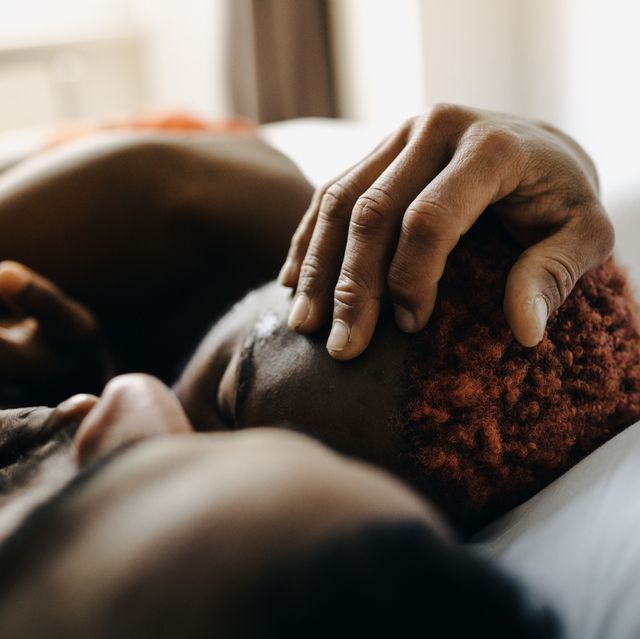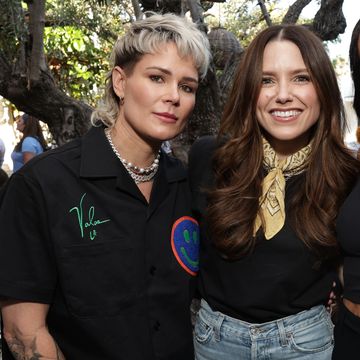Cuddle monster. Make-out maniac. Back-scratch lover.
If you’ve ever been dubbed (or resonate with) any of these nicknames, odds are you need a lot of skin-on-skin to feel special. True to you? Well, physical touch could be your love language.
If you’ve ever fallen down an online quiz rabbit hole (#relatable), you’re probably familiar with the concept of physical touch and the various love languages.
ICYMI, here’s a quick refresher: Love languages is a concept that was created and coined by anthropologist and marriage counselor Gary Chapman, PhD in 1992 with the release of his book The Five Love Languages: How to Express Heartfelt Commitment to Your Mate, explains Carolina Pataky, PhD, a sex therapist and founder of South Florida's Love Discovery Institute.
While the text is more than three decades old, the framework still has utility today. “It can still serve as a helpful guide to understanding the art of knowing how you and your partner feel loved and appreciated,” she says.
The gist? There are five main ways that people give and receive love: through acts of service, through quality time, through words of affirmation, through gifts, and through physical touch, she explains.
Each of the love languages is more or less what it sounds like. People whose love language is words of affirmation, for example, like to hear a kind word or praise. While people whose love language is quality time require a decent amount of intentional hanging out with their lovers.
And, as you might guess, people whose love language is physical touch need strokes on strokes on strokes on strokes.
“People who have touch as their primary love language need physical contact (touch) to feel loved,” she says. Without proper types (or frequencies) of touch, these folks can feel like they aren’t cherished. Not ideal.
That’s why Pataky says knowing your own and your partners' primary love language is essential. “It helps make sure you’re expressing care and appreciation in a language that your partner understands—and vice versa,” she says. Bluntly, this love language thing is no small potatoes.
Intrigued? Ahead, sex and relationship educators explain exactly what it means if your love language is physical touch. (Spoiler alert: It doesn’t mean you’re horny 24/7). They also share how to show love to someone who receives it via physical touch, whether you live near or far.
What does it mean if physical touch is your love language?
Put simply, someone whose love language is physical touch feels most loved, appreciated, and valued when they are touched. But we’re not talking any old types of touch, according to Pataky. “The touch is an intentional touch of deep appreciation,” she says.
Despite common misconception, however, physical touch isn’t just sexual. “The touch doesn’t necessarily have to be erotic,” says Pataky. People whose love language is touch might just enjoy holding hands in public or sitting on their partner’s lap during a movie, she says. (For the record: Someone might have a high libido and enjoy regular sex with their partner, but have one of the other four love languages).
There are a number of factors that influence how a person most likes to receive love—including how love was or wasn’t expressed in their family growing up. But as far as physical touch is concerned, there’s actually a hormonal component, too. “When we experience physical touch, we release certain hormones and neurotransmitters such as oxytocin, serotonin, and dopamine,” says Pataky. And these hormones make us feel good. Like, good good. Unsurprisingly, these have been dubbed the love and cuddle hormones, respectively.
Oh, and to be clear: Most people have more than one love language. Actually, if you take this online love language quiz right now you’ll likely learn that you need a little bit of all five to feel swooned over.
It’s also important to recognize that the way you give love and receive love may be different, so the way you like to show people that your heart-eyes for them may be different than how you like to be shown that someone heart-eyes you.
What are the signs that physical touch is your love language?
Alright babes, time for a little self-reflection. If you’re in a relationship (or, err, situationship) ask yourself: When was the last time my person made me feel super cared for? If it was when they gave you a foot massage after a long run, or when you twirled and swirled to jazz together in your living room, or when they touched your knee under the table at your parents house, odds are physical touch is your love language.
“Individuals who are more loved after random physical gestures than receiving gifts or hearing words of affirmation, likely have physical touch as their love language,” says Pataky.
You might also spend a lot of time engaging in PDA. Do all people who have touch as their primary love language wanna make out in local parks like horny teenagers? No. But TBH the percentage is pretty high, according to Pataky. “It’s very common for individuals whose love language is physical touch to love receiving and giving public displays of affection and feel weird if they are not touching their partner in public when their partner is near them,” she says.
Physical touch may also be your love language if you have ever described yourself as, “really touchy feely,” “a really good hugger,” or “kinda a cuddle monster." As Pataky explains, usually if touch is your love language in your romantic relationship(s), it’s also one of your love languages in your platonic relationships, too.
“Yes, physical touch can be how you like to receive love from your friends, too,” she says. It just might look different (read: less sexual). “Usually, it looks like wanting to sit close to your friends, wanting to be hugged when sad, and petting them with praise when deserved,” she explains.
Get to know all of the love languages here:
How do I cater to someone who’s love language is physical touch?
Spoiler alert: Not all lovers who enjoy physical touch are the same. One person who’s love language is physical touch might enjoy getting their scalp scratched, while another is too protective of their hair. Likewise, one might enjoy hand-holding, while another finds the whole shebang sweaty and annoying. So ultimately, how you show your love via touch will vary based on how your lover likes to receive said love.
“If your partner has mentioned that their love language is touch, ask them to elaborate,” suggests NYC relationship therapist Darcy Sterling, PhD, host of E! Network’s Famously Single and creator of an online course about love and relationships. “That way you can be certain to deliver the specific types of touch that actually help them feel cared for,” she says.
In general, however, she recommends incorporating various acts of physical gestures such as hugs, arm squeezes, forehead kisses, and leg grazes into your encounters with your boo. “It can also be useful to touch them during stories and social interactions to show that you’re tuned into them,” she says.
Finally, remember: Having your love language be physical touch is different from having a high libido. Sure, there’s some overlap in that Venn diagram. But taking your sweetie to the sheets (consensually, ofc) isn’t the only way to cater to their love language. Heck, it might not even be their preferred way.
What if I’m in a long-distance relationship?
If your love language is physical touch but your boo lives a plane-ride away, fear not—your relationship isn’t doomed. With a little creativity, coin, and forethought there are ways to simulate touch from afar. Phew!
Sensitive schnoz? Have your partner lend you their hoodie without washing so it smells like them. Then, wear or snuggle the article whenever you want to feel close to them. If you and your partner are different sizes, a snuggle, pillow case, or throw may work better. If it’s the weight of your partner you miss, you might consider getting a weighted blanket or pregnancy pillow. Better: Spritz that weighted blanket or pillow with your lover’s signature scent.
Another option is to talk about physical touch. In other words, sext. How would you greet your partner when they came home from work if you lived together? How would you touch your partner if they were laying next to you? What part of their body do you miss the most? Let them know. According to Pataky, talking about sexual and sensuous touches can hint at some of the intimacy of actual touches.
Depending on your personal finances, you can also treat one another (or yourselves) to physical acts of care, she suggests. Think: a massage, mani/pedi, acupuncture, and blow out appointment. Obviously, getting touched by a masseuse or manicurist is different from getting touched by a lover, in terms of both degree, kind, and intent.
But the act of being stroked in service-oriented ways may still release some of the feel-good hormones (heya, oxytocin) that other kinds of touch do, she says. “Sure, you may not be able to directly extend the touch directly, but in buying them a physical act of service you’re letting them know that you understand how important this may be for them,” she says.
Finally, visit as regularly as you can (or can afford). “As great as video calls are, they aren’t going to compensate for the distance the way they might for someone whose primary love language is words of affirmation,” says Sterling. “If you or your partner have touch as a primary love language, you’re going to have to commit to visiting regularly,” she says. *Immediately pulls up Google calendar*.

Gabrielle Kassel (she/her) is a sex and wellness journalist who writes at the intersection of queerness, sexual health, and pleasure. In addition to being in Cosmopolitan, her work can also be found in publications such as Shape, Well + Good, Women’s Health, Health, Self, Men’s Health, Greatist, and more! In her free time, Gabrielle can be found reviewing one of the nearly 1,000 pleasure products she's tested, reading smut, or recording episodes of the podcast she cohosts called Bad In Bed. Follow her on Instagram @GabrielleKassel.













